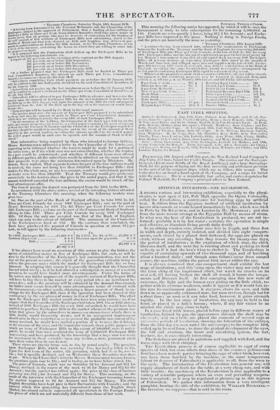ARTIFICIAL INCUBATION-THE ECCALE01310N.
A ntettitx carious and interesting exhibition, especially to the physi- ologist, is now open at 121, Pall Mall, opposite the Opera Colonnade,
called the Eccaleobion, a contrivance for hatching eggs by artificial heat. It differs from the. Egyptian method of artificial incubation by means of mammals, or ovens heated immediately by fire, which was tried in Paris by DE REAumuu, and in London by Mr. MOWBRAY ; and also from the more recent attempt at the Egyptian Ilall by means of steam. In what way the heat of the Eccaleobion is produced, we are not in- tiirmed ; probably it is by hot water ; certainly the operation is simple and effective, as abundant living proofs daily testify.
In an oblong wooden ease, about nine feet in length, and three feet in width and depth, entirely isolated, and divided into eight compart- ments, each closed by a glazed door darkened, the eggs are placed on cloth, without any covering ; here they remain for twenty-one days, the period of incubation ; at the expiration of which time, the chick liberates itself, and the next day is running about and pecking its food as lively as it' it had the lien's wing to shelter it. The Eccaleobion is capable of containing, upwards of two thousand eggs, and of hatching abnut a hundred daily ; and though some failures occur from natural causes, the machine, unlike the parent bird, never addles the egg.
It is always contrived that one compartment shall exhibit the last stage of incubation ; and this 'Jeing open, the visitor may not only hear the fItint chirp of the imprisoned chick, but watch its attacks on its oval cell, till having broken the shell all round, it bursts the integu- ments aad liberates itself. At first emerging into this new state of existence, the light and the human eyes gazing on the little chick, to- gether with its extreme weakness, make it appear as if it would fain re- tire into its confinement again : it staggers, closes its eyes, and falls down in an apparently exhausted state, but soon revives, though but for a short time ; as soon as it can take food, however, it gains strength rapidly. In the last stage of incubation, the egg may be held in the hand, or placed in a lady's bosom ; where, if any fair visiter be so minded, the chick may come to light.
In a case fitted with lenses, placed before eggs in different stages of incubation, lighted by gas, the appearances through the shell may be obs;?rved ; and on a table are placed the contents of several eggs at successive periods of incubation, showing the formation of the embryo, from the first day (as seen under the microscope) to the complete bird, coiled up in its oval form ; to trace the gradual development of the eyes, the bill and cranium, the heart and circulating system, the feet, feathers-, &e. is exceedingly interesting.
The fledglings are placed in partitions and supplied with food, and the room rings with their chirping.
The Ecealeobion process is of course applicable to eggs of every species of bird, but none others than those of the common gallinaceous fit w I have been reared: part i es bringing the eggs of other birds, however, can have them hatched by the machine, as the same temperature (about 9R degrees of Fahrenheit) is applicable to all, from the wren to the eagle. The introduction of the Eccaleobion into general use, will supply abundance of fowls for the table, at a. very cheap rate, and with little trouble : the machinery of the Eccaleobion is also applicable to a variety of scientific purposes, where an even and pervading tempera- ture is required ; as it may be regulated at pleasure up to 300 degrees of Fahrenheit. We gather this int'ormation from a very intelligent pamphlet, bearing thg title of the exhibition, by WILLIAn BucasELL- the inventor, we suppose-that is sold in the room.


























 Previous page
Previous page